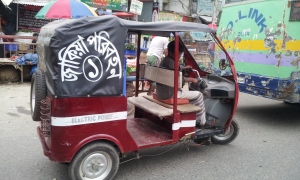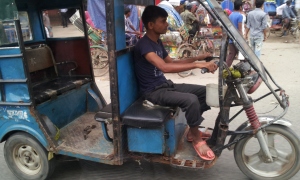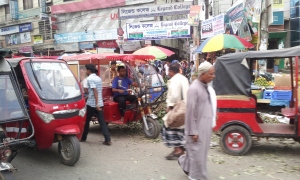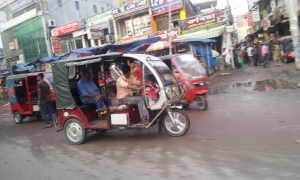We have learnt from the news media that Indonesia was considering to provide Bangladeshi citizens visa upon arrival facilities for 30 days validity and now finally it has come into effect. Someone recently shared a post in the Facebook, a picture of a Bangladeshi passport page with Indonesian visa upon arrival stamped. This is a good news for Bangladeshi citizens as it lessened the hassle of obtaining visa from the Indonesian Embassy before travelling. In order to boost tourism, the Indonesian government has recently eased visa restrictions for quite a number of countries. Citizens of these countries can now enjoy visa upon arrival facility at Indonesian airports and fortunately Bangladesh is one of them to gain this opportunity.
This is also advantageous for people like me who are engaged in frequent travelling to various countries for professional reasons. I do need to travel frequently as our office is a regional coordinating body of a worldwide youth organization. My colleagues hailing from various countries of Asia, mostly East and Southeast Asia face less difficulties for visa matters. In most of the countries, when they travel, they are entitled to visa upon arrival or no visa at all. For me, our travel agency has to run to various consulate offices, here in Hong Kong, to obtain my visas. I need to obtain visa to travel almost everywhere, except Bangladesh, they jokingly say. Personally, being a Bangladeshi, this is a sad experience for me. There are countries like Timor Leste, Sri Lanka, Bhutan and Nepal, where we Bangladeshi’s can visit without prior visa and no other countries in Asia extended us with visa upon arrival facility. I still remember the days when we could travel to Hong Kong, Thailand or even South Korea, with visa upon arrival system, but those days are long past now.
According to the Global Passport Index, (www.passportindex.org) in the individual ranking Bangladesh falls in 188th position with only 37 countries of the world accepting Bangladeshi citizens either with visa upon arrival or visa free facilities. Pakistan and Afghanistan falls on 198th and 199th position respectively, their citizens enjoying either on visa upon arrival or visa free facilities to only 28 and 29 countries respectively. Afghanistan is in the bottom of the list while Germany’s is in the first position with a total of 157 countries offering visa free or visa on arrival facilities to German citizens.
Obviously there are reasons for such an attitude on the part of the majority of countries towards us, the Bangladeshis. The affluent countries have been closing the doors for us, ever since. Even with proper documents, getting a visa for some countries in the West is so difficult. One has to prove with all documentary evidences that he or she will return back after the visit.
Why this is happening ? Plainly one may say that, when a Bangladeshi travels to an affluent country there has always been a tendency for him to stay back in that country illegally; especially in the cases of young people who are in pursuit of a better standard of living. Poverty and unemployment in the country is the root of the problem for people tending to migrate. The second reason is terrorist militancy; in a lot of cases, there have been links between Bangladeshis and terrorist militancy in the Middle East. The Rohinga refugees residing in the south-east part of Bangladesh is also an issue. It is an open secret, that a good number of these stateless refugees by adopting unfair means and in collaboration with a section of our people have managed to secure Bangladeshi passports, travelled abroad, engaged in illegal activities such getting involved in terrorist activities in Middle East where they worked as mercenary in the wars of Afghanistan, Palestine, Iraq and now Syria.
These are the reasons why other countries are reluctant to extend us visas, considering us a threat to their own national security. One good example could be Cambodia; economically this country does not have better profile than Bangladesh, still it is difficult for a Bangladeshi to enter Cambodia. Cambodia is a country which has an open policy to entertain citizens of any country with a visa upon arrival facility, however, there is an exception, this is not applicable to citizens of nine countries. Unfortunately, Bangladesh falls into this category and the other countries are Pakistan, Afghanistan, Iraq, Iran, Somalia, Sudan, Sri Lanka, and Saudi Arabia. Citizens of these countries are required to obtain prior visa to travel to Cambodia. Even after obtaining a prior visa, Bangladeshis are subjected to face some sort of questioning and harassment at the immigrations of Cambodian airports.
This is a matter of the reputation or image of our country, this is what the world perceives about us. The countries mentioned above are mostly the failed countries, infamous for militancy activities and no law and order situation prevailing. Now our government has to work more effectively to put ourselves in a better position, especially tackling militancy problem in our country.
Our economy is growing and so is as the living standards of our people, more and more people are travelling to various countries but the majority of them go to East Asia and Southeast Asian countries, mainly for tourism purpose. Introduction of budget airlines has also boosted overseas travelling, but the visa problems still remains for Bangladeshis.
One of the solutions could be, that countries of the East Asia and Southeast Asia like Thailand, Malaysia, Singapore, Hong Kong, Korea, Japan, etc., where more and more Bangladeshi people are travelling can provide visa upon arrivals to Bangladeshi visitors on the condition that they have previously visited the country within the period of the last one or two years. Obviously, people who can afford to visit that country at frequent intervals and have not overstayed in the earlier visit, will most likely never overstay in the subsequent visits. Another provision could be that Bangladeshi’s who are holding valid visas for USA, Canada, Australia, UK or Schengen States could be provided with visa upon arrivals. These Western countries do a lot of background checks before providing long time visa hence trusting those visas could help avoid duplication of work.
The foreign ministry of Bangladesh needs to be proactive in this matter and be able to effectively negotiate with their overseas counterparts in making travelling for Bangladeshis more hassle-free by easing visa procedures. In the long term, we need to toil to improve the overall performance of the country, creating a secular image of the country and totally eliminating militancy from the country by showing zero tolerance to such activities. We let us toil together to take our country to that stage when a Bangladesh will be among the leading countries in passport power ranking in the world. The passport power ranking reflects the prosperity and acceptability of the country.
Duncan Chowdhury is a YMCA Executive and writes from Hong Kong.
(This article was published in the print version of The Daily Sun on 13 April 2016)




